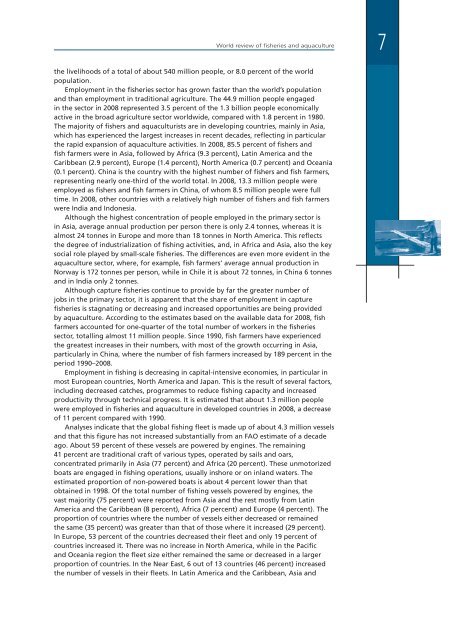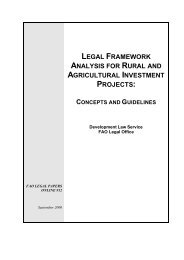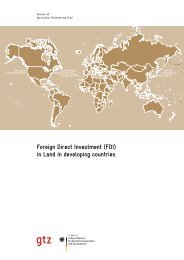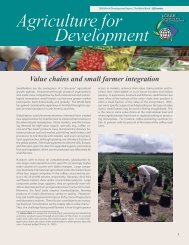The State of World Fisheries and Aquaculture 2010 - FAO
The State of World Fisheries and Aquaculture 2010 - FAO
The State of World Fisheries and Aquaculture 2010 - FAO
You also want an ePaper? Increase the reach of your titles
YUMPU automatically turns print PDFs into web optimized ePapers that Google loves.
<strong>World</strong> review <strong>of</strong> fisheries <strong>and</strong> aquaculture<br />
7<br />
the livelihoods <strong>of</strong> a total <strong>of</strong> about 540 million people, or 8.0 percent <strong>of</strong> the world<br />
population.<br />
Employment in the fisheries sector has grown faster than the world’s population<br />
<strong>and</strong> than employment in traditional agriculture. <strong>The</strong> 44.9 million people engaged<br />
in the sector in 2008 represented 3.5 percent <strong>of</strong> the 1.3 billion people economically<br />
active in the broad agriculture sector worldwide, compared with 1.8 percent in 1980.<br />
<strong>The</strong> majority <strong>of</strong> fishers <strong>and</strong> aquaculturists are in developing countries, mainly in Asia,<br />
which has experienced the largest increases in recent decades, reflecting in particular<br />
the rapid expansion <strong>of</strong> aquaculture activities. In 2008, 85.5 percent <strong>of</strong> fishers <strong>and</strong><br />
fish farmers were in Asia, followed by Africa (9.3 percent), Latin America <strong>and</strong> the<br />
Caribbean (2.9 percent), Europe (1.4 percent), North America (0.7 percent) <strong>and</strong> Oceania<br />
(0.1 percent). China is the country with the highest number <strong>of</strong> fishers <strong>and</strong> fish farmers,<br />
representing nearly one-third <strong>of</strong> the world total. In 2008, 13.3 million people were<br />
employed as fishers <strong>and</strong> fish farmers in China, <strong>of</strong> whom 8.5 million people were full<br />
time. In 2008, other countries with a relatively high number <strong>of</strong> fishers <strong>and</strong> fish farmers<br />
were India <strong>and</strong> Indonesia.<br />
Although the highest concentration <strong>of</strong> people employed in the primary sector is<br />
in Asia, average annual production per person there is only 2.4 tonnes, whereas it is<br />
almost 24 tonnes in Europe <strong>and</strong> more than 18 tonnes in North America. This reflects<br />
the degree <strong>of</strong> industrialization <strong>of</strong> fishing activities, <strong>and</strong>, in Africa <strong>and</strong> Asia, also the key<br />
social role played by small-scale fisheries. <strong>The</strong> differences are even more evident in the<br />
aquaculture sector, where, for example, fish farmers’ average annual production in<br />
Norway is 172 tonnes per person, while in Chile it is about 72 tonnes, in China 6 tonnes<br />
<strong>and</strong> in India only 2 tonnes.<br />
Although capture fisheries continue to provide by far the greater number <strong>of</strong><br />
jobs in the primary sector, it is apparent that the share <strong>of</strong> employment in capture<br />
fisheries is stagnating or decreasing <strong>and</strong> increased opportunities are being provided<br />
by aquaculture. According to the estimates based on the available data for 2008, fish<br />
farmers accounted for one-quarter <strong>of</strong> the total number <strong>of</strong> workers in the fisheries<br />
sector, totalling almost 11 million people. Since 1990, fish farmers have experienced<br />
the greatest increases in their numbers, with most <strong>of</strong> the growth occurring in Asia,<br />
particularly in China, where the number <strong>of</strong> fish farmers increased by 189 percent in the<br />
period 1990–2008.<br />
Employment in fishing is decreasing in capital-intensive economies, in particular in<br />
most European countries, North America <strong>and</strong> Japan. This is the result <strong>of</strong> several factors,<br />
including decreased catches, programmes to reduce fishing capacity <strong>and</strong> increased<br />
productivity through technical progress. It is estimated that about 1.3 million people<br />
were employed in fisheries <strong>and</strong> aquaculture in developed countries in 2008, a decrease<br />
<strong>of</strong> 11 percent compared with 1990.<br />
Analyses indicate that the global fishing fleet is made up <strong>of</strong> about 4.3 million vessels<br />
<strong>and</strong> that this figure has not increased substantially from an <strong>FAO</strong> estimate <strong>of</strong> a decade<br />
ago. About 59 percent <strong>of</strong> these vessels are powered by engines. <strong>The</strong> remaining<br />
41 percent are traditional craft <strong>of</strong> various types, operated by sails <strong>and</strong> oars,<br />
concentrated primarily in Asia (77 percent) <strong>and</strong> Africa (20 percent). <strong>The</strong>se unmotorized<br />
boats are engaged in fishing operations, usually inshore or on inl<strong>and</strong> waters. <strong>The</strong><br />
estimated proportion <strong>of</strong> non-powered boats is about 4 percent lower than that<br />
obtained in 1998. Of the total number <strong>of</strong> fishing vessels powered by engines, the<br />
vast majority (75 percent) were reported from Asia <strong>and</strong> the rest mostly from Latin<br />
America <strong>and</strong> the Caribbean (8 percent), Africa (7 percent) <strong>and</strong> Europe (4 percent). <strong>The</strong><br />
proportion <strong>of</strong> countries where the number <strong>of</strong> vessels either decreased or remained<br />
the same (35 percent) was greater than that <strong>of</strong> those where it increased (29 percent).<br />
In Europe, 53 percent <strong>of</strong> the countries decreased their fleet <strong>and</strong> only 19 percent <strong>of</strong><br />
countries increased it. <strong>The</strong>re was no increase in North America, while in the Pacific<br />
<strong>and</strong> Oceania region the fleet size either remained the same or decreased in a larger<br />
proportion <strong>of</strong> countries. In the Near East, 6 out <strong>of</strong> 13 countries (46 percent) increased<br />
the number <strong>of</strong> vessels in their fleets. In Latin America <strong>and</strong> the Caribbean, Asia <strong>and</strong>













